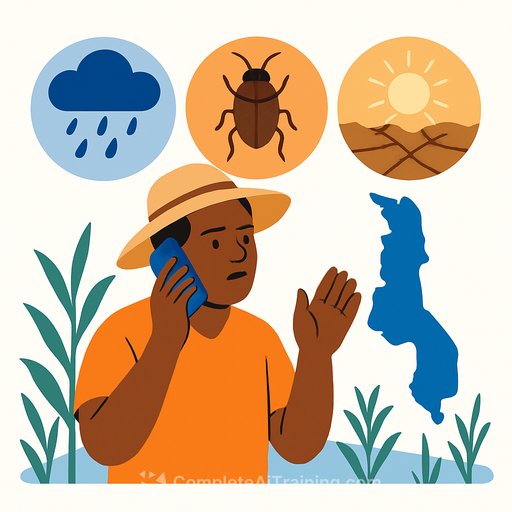Malawi's new farmhand: AI that speaks the local language
Ulangizi AI is giving small-scale farmers in Malawi on-demand, local-language advice - through voice, text, and photos - to tackle pests, drought, and misinformation. It blends large language models with government guidelines and traditional know-how, delivered over channels farmers already use like WhatsApp. With climate stress rising and too few extension officers, this kind of instant, trusted guidance is filling a real gap.
A voice in Chichewa that saves crops
When aphids hit her wilting okra, Alifosina Mtseteka tried every fix she knew. Nothing worked. A neighbor spoke her problem into a phone in Chichewa, and Ulangizi advised a specific insecticide. She sprayed, the okra recovered, and a season was saved.
Mtseteka doesn't own a smartphone. That didn't matter. A local "support agent" acted as the bridge - a practical model for communities where digital skills and devices are uneven.
What Ulangizi AI does (and how)
Ulangizi answers questions via text or voice and can diagnose issues from photos of crops and livestock. It draws on Malawi's agricultural guidelines and community practices, then explains steps in plain Chichewa. Early versions stumbled - odd accents, awkward phrasing - but iterative updates made it usable and trusted.
Distribution is simple: WhatsApp. Adoption is human: train the most tech-comfortable farmers as on-the-ground helpers. That "human in the loop" setup accelerates onboarding, builds confidence, and catches bad suggestions before they spread.
Real results, real limits
On a 2-acre farm in Chiradzulu, Kingsley Jasi saw worms tearing through corn. His usual insecticide damaged plants. He sent a photo to Ulangizi on WhatsApp, got a different recommendation, and cleared the worms. Since then, he's leaned on the bot for quick decisions.
Constraints are clear. There's roughly one extension officer for every 3,000 farmers, so demand for help is huge. The AI still makes mistakes: a term like "witch hazel" was flagged as witchcraft until retrained. Content needs frequent updates because pests, practices, and weather risks shift with each season. Farmers want forecasts integrated so they can plan planting and irrigation with more confidence.
Why this matters for IT and development teams
- Start with distribution you already have: WhatsApp beats building a new app for low-connectivity regions.
- Use retrieval-augmented generation with vetted sources (government guidelines, field manuals, local practices) to reduce bad advice.
- Support low-resource languages: tune prompts, add pronunciation guides, and customize ASR/TTS for accents and code-switching.
- Keep a human layer: train local support agents, create escalation paths to extension officers, and capture feedback as data.
- Build a domain glossary and allowlists to avoid moderation false positives (e.g., "witch hazel").
- Measure what matters: time-to-answer, resolved vs. escalated cases, crop outcomes, and farmer satisfaction.
- Optimize for constraints: compress models, cache instructions, and design for patchy bandwidth and shared-device use.
- Fund access: device financing and data bundles move adoption from pilot to daily use. Partnerships help.
One example: device access in Malawi improved as farmers received phones through GiveDirectly, unlocking a path to information and income tools.
A practical playbook to build something similar
- Define scope: pick 20-30 high-volume farm problems you can answer reliably before expanding.
- Ingest trusted content: digitize ministry manuals, extension guides, and vetted community practices; add sources with provenance.
- RAG setup: clean, chunk, and tag content; use conservative prompts; log citations with each answer.
- Evaluation: create a gold set of Q/A pairs in the target language; track accuracy, safety, and clarity per crop and region.
- Language and voice: fine-tune ASR/TTS for the local dialect; keep offline fallback prompts and audio playback.
- Channel integration: deploy on WhatsApp and SMS for reach; keep UI simple with quick-reply buttons and image prompts. Docs: WhatsApp Business Platform.
- Safety and approvals: align with ministry recommendations; block restricted chemicals; flag unknowns for human review.
- Update loop: weekly content refresh from field reports; seasonal pest and disease briefs; clear versioning.
- Weather-aware advice: integrate localized forecasts and drought/flood alerts; adapt planting and pesticide timing.
- Ops: train local agents, schedule village clinics, and route edge cases to extension officers.
The broader signal
This isn't about fancy features. It's about removing friction between a farmer's question and a useful answer - in their language, on their terms, at the exact moment they need it. Do that well, and you don't just save a crop. You steady a family's income.
If you're building domain assistants and want deeper practice with prompts, guardrails, and RAG, explore our prompt engineering resources: Complete AI Training - Prompt Engineering.
Your membership also unlocks:






